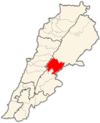|
Karak Nuh
Karak (also Kerak, Karak Nuh or Karak Noah) (Arabic: كرك, romanized: Karak) is a village in the municipality of Zahlé in the Zahle District of the Beqaa Governorate in eastern Lebanon.[1] It is located on the Baalbek road close to Zahle. Karak contains a sarcophagus claimed by the locals to be the tomb of Noah.[2] The inhabitants of Karak are Melkites, Maronites and Shia Muslims.[3] HistoryThe town was an important religious site during the Middle Ages, drawing devotion from the local rural village communities.[2] The town was known as al-Karak during the time of the Ayyubid dynasty and changed to Karak Nuh under the Mamluks.[4] In medieval period, the Shia muhaddith Ahmad bin Tariq bin Sinan (b. 1132) was born in the town. In the mid-13th century, the settlement to the north of Karak Nuh, Bḥaouchiyya, was inhabited by Tanukhid emirs from Mount Lebanon who practiced the Shia faith.[5] Karak Nuh gradually became known as a center of learning for Shia Islam and the administrative centre of the southern Beqaa. Under the Mamluks Karak Nuh served as the administrative center of southern Beqaa. Damascene historian Shams al-Din ibn Tulun (1475–1546), who visited the town noted that "its people were famous for their Shia faith".[citation needed] A Safavid sheikh, Ali al-Karaki, and various dignitaries were born in the town. In 1533–1548, the town was the second largest in the Beqaa valley after Baalbek, comprising 590 households, all Muslims.[6] The town was largely devastated in strife between the Yunus Harfush and Fakhreddine in 1623 and as a result was abandoned for several decades,[7] with many of its inhabitants moving to Jabal Amel.[citation needed] A major earthquake damaged the town's distinguishing minaret in 1705, which required repair by the 'Alwan family.[2] In 1838, Eli Smith noted el-Kerak's population being Metawileh and Catholics.[8] Tomb of NoahAccording to tradition mentioned by al-Mukaddasi and Al-Dimashqi, the tomb of Noah existed in the tenth century and can still be seen. The stone tomb measures around 104.8 feet (31.9 m) long, 8.7 feet (2.7 m) wide and 3.2 feet (0.98 m) high and is covered in a worn green cloth. It is housed in a room measuring 10.1 feet (3.1 m) by 8.1 feet (2.5 m).[9][10][11] There is a chapel next to the cenotaph building where several inscriptions (decrees) dating to the fourteenth century were found.[12] There is also a courtyard outside the building with a prayer niche. The size of the monument possibly derives from tales of ancient giants, but is more realistically suggested to be a section of an ancient aqueduct that has been converted to serve as a shrine.[10][13] ArchaeologyA Roman inscription in Latin dating to the year 84 CE was found in the basement of a house to the south west of the tomb that called for the long life of the "man with many names".[10] LocaleNear to the town is the Ayn al-Garr spring and Massyas lake and marshes that are considered to be the source of the Litani river.[14] Notable people
See alsoReferences
Bibliography
External links |
||||||||||||||||||

